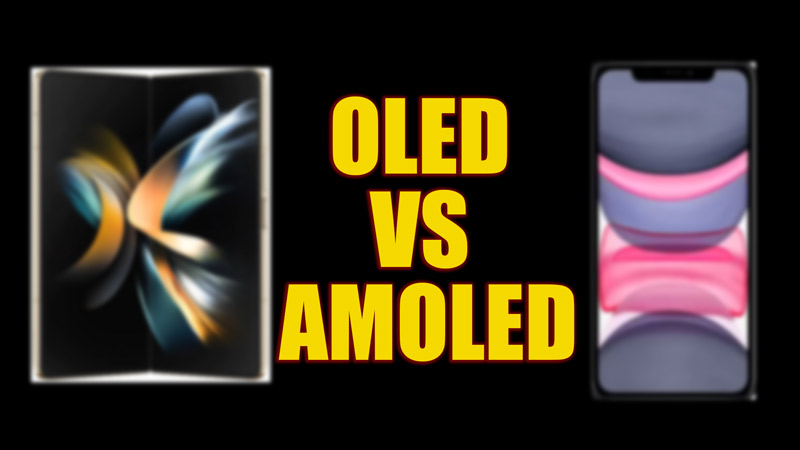If you are looking for a new smartphone, tablet, or TV, you might have come across the terms AMOLED and OLED. These are two types of display technologies used in various devices. But what are the differences between them and which one is better for you? Answers to such questions are in this AMOLED vs OLED comparison guide.
AMOLED vs OLED: Which is the Best Display Technology (2023)

Both AMOLED and OLED use light-emitting diodes made up of different materials. Hence, they have their own advantages and disadvantages. So to know which display type is the best we have considered criteria like materials, color accuracy, brightness, burn-in, and cost, as mentioned below:
1. Material
AMOLED display uses an active matrix of thin-film transistors (TFTs) to control each pixel. This allows for faster response times, higher brightness, and lower power consumption than OLED displays. AMOLED displays are flexible and can be curved or folded to create different shapes and sizes. On the other hand, OLED displays use organic materials to emit light when an electric current passes through them. Also, they do not need a backlight to illuminate the screen like LCDs. This means they can produce deeper blacks, higher contrast ratios, and wider viewing angles. OLED displays are also thinner and lighter than traditional LCDs.
2. Color accuracy
AMOLED displays tend to have more saturated and vivid colors than OLED displays. This can make images and videos look more appealing and eye-catching, but it can also distort the original colors and make them less realistic. OLED displays tend to have more natural and accurate colors than AMOLED displays. This can make images and videos look more faithful to the source, but it can also make them less vibrant and exciting.
3. Brightness
AMOLED displays tend to have higher brightness levels than OLED displays. This can make them more visible and readable in bright environments, such as outdoors or under direct sunlight. OLED displays tend to have lower brightness levels than AMOLED displays. This can make them more comfortable and less straining for the eyes in dark environments, such as indoors or at night.
4. Burn-in
AMOLED displays tend to be more prone to burn-in than OLED displays. Burn-in is a phenomenon where a static image or a part of an image remains on the screen even after it changes or disappears. This can happen when the same image or a part of an image is displayed for a long time or repeatedly on the screen. For example, if you use your smartphone for navigation or gaming for a long time, you might notice some ghosting or fading of the icons or buttons on the screen. OLED displays tend to be less prone to burn-in than AMOLED displays because they use different organic materials that degrade more evenly over time.
5. Cost
AMOLED displays tend to be more expensive than OLED displays because they require more complex and sophisticated manufacturing processes and materials. This means the devices that use OLED displays are cheaper than AMOLED. So, when you are purchasing a device like a smartphone you can settle for OLED. But if you are purchasing a luxury device like a Smart TV you can go for AMOLED if you take cost into account because the bigger the screen cheaper the manufacturing cost of the display becomes.
In the end, if you want a display that has more vibrant colors, higher brightness, and lower power consumption, you should go for an AMOLED display. But if you want a display that has more accurate colors, deeper blacks, and less burn-in risk, you should go for an OLED display.
With that the AMOLED vs OLED comparison guide ends. Also, check out our other guides, such as the OLED vs MicroLED comparison guide to know the difference between them or the LED vs OLED comparison guide to know which is the best TV.
